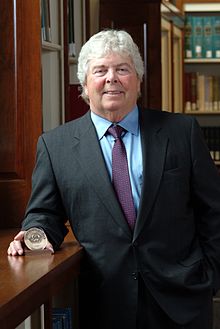Herb Boyer
| Herbert Boyer | |
|---|---|

Herbert Boyer receiving Winthrop Sears Medal, 2005
|
|
| Born | July 10, 1936 |
| Fields | Biology |
| Alma mater |
Saint Vincent College (B.S., 1958) University of Pittsburgh (Ph.D. 1963) |
| Notable awards | National Medal of Science (1990) |
Herbert Wayne "Herb" Boyer (born July 10, 1936) is a researcher and entrepreneur in biotechnology. Along with Stanley N. Cohen and Paul Berg he discovered a method to coax bacteria into producing foreign proteins, thereby jump starting the field of genetic engineering. He is recipient of the 1990 National Medal of Science, co-recipient of the 1996 Lemelson–MIT Prize, and a co-founder of Genentech. He served as Vice President of Genentech from 1976 until his retirement in 1991.
Boyer was born in Derry, Pennsylvania. He received his bachelor's degree in biology and chemistry from Saint Vincent College in Latrobe, Pennsylvania, in 1958. He married his wife Grace the following year. He received his PhD at the University of Pittsburgh in 1963 and participated as an activist in the civil rights movement. He spent three years in post-graduate work at Yale University in the laboratories of Professors Edward Adelberg and Bruce Carlton, then became an assistant professor at the University of California, San Francisco and a Professor of Biochemistry from 1976 to 1991, where he discovered that genes from bacteria could be combined with genes from eukaryotes. In 1977, Boyer's laboratory and collaborators Keiichi Itakura and Arthur Riggs at City of Hope National Medical Center described the first-ever synthesis and expression of a peptide-coding gene. In August 1978, he produced synthetic insulin using his new transgenic genetically modified bacteria, followed in 1979 by a growth hormone.
...
Wikipedia
